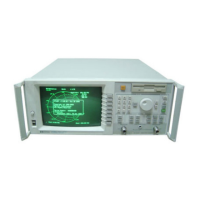I
-
Using Limit Testing
Limit testing is a measurement technique that compares measurement data to
constraints that you define. Depending on the results of this comparison, the
analyzer can indicate if your device either passes or fails the test.
Limit testing is useful for real-time tuning of devices to specifications. When
limit testing is turned on, pass/fail results can be output to the display and
also to the LIMIT TEST TTL IN/OUT connector on the rear panel. See “BNC
Connectors,
”
in Chapter 8 for more information.
Limit testing is implemented by creating individual flat, sloping, or single
point limits on the analyzer display. These types of lines may be used
individually or combined to represent the performance parameters for your
device under test. Also available are limit testing capabilities for five types
of marker searches: statistical mean, peak-to-peak ripple, flatness, delta
amplitude, and delta frequency.
NOTE
Limit testing is only performed on the measurement data trace. It cannot be performed on a memory
trace.
Limit line testing is not available when the analyzer is in Smith chart or polar format. If limit lines are
on and you change to Smith chart or polar format the analyzer will automatically turn off the limit
4-31

